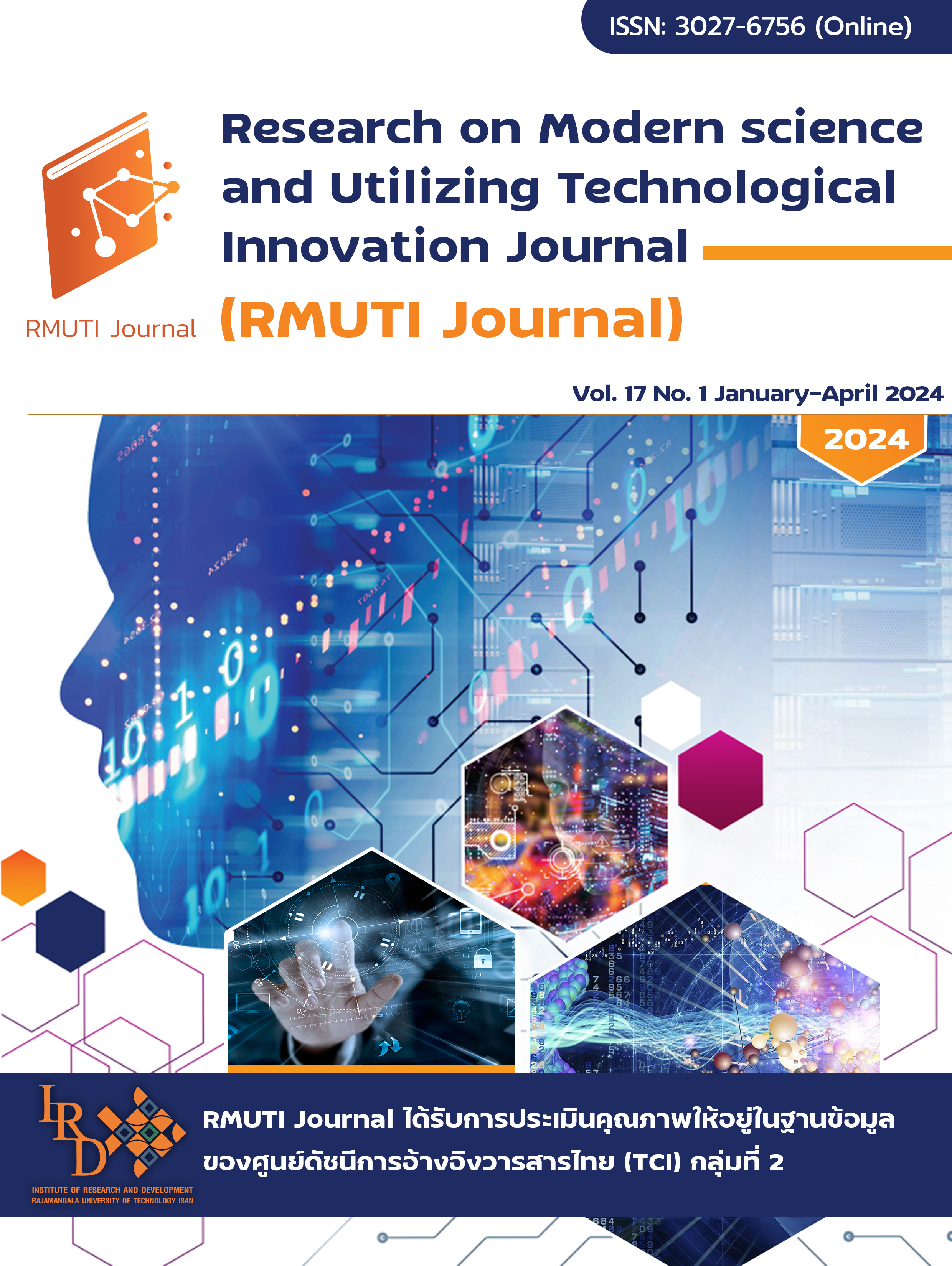กําลังของซีเมนต์มอร์ตาร์ผสมเถ้าลอยไม้ยางพาราจากอุตสาหกรรม
Main Article Content
บทคัดย่อ
งานวิจัยนี้มีวัตถุประสงค์เพื่อศึกษากำลังของซีเมนต์มอร์ตาร์ที่ผสมเถ้าลอยไม้ยางพาราจากอุตสาหกรรม โดยใช้เถ้าลอยไม้ยางพาราแทนที่ปูนซีเมนต์ไฮดรอลิกชนิดใช้งานทั่วไป (GU) และปูนซีเมนต์ ปอร์ตแลนด์ประเภททที่ 1 (PC) ในอัตราส่วนร้อยละ 0 10 20 และ 30 โดยนํ้าหนักของวัสดุประสาน ใช้อัตราส่วนนํ้าต่อซีเมนต์ที่ทําให้มอร์ตาร์มีค่าการไหลเท่ากับ 110±5 ทําการทดสอบกําลังอัด กําลังดัด และกําลังดึง จากผลการวิจัยพบว่า (1) กําลังอัดของมอร์ตาร์ มีค่าลดลงตามปริมาณเถ้าลอยไม้ยางพาราที่เพิ่มมากขึ้น แต่อย่างไรก็ตามมอร์ตาร์ปูนซีเมนต์ GU สามารถใช้เถ้าลอยไม้ยางพาราได้ถึงร้อยละ 20 ส่วนมอร์ตาร์ปูนซีเมนต์ PC สามารถใช้เถ้าลอยไม้ยางพาราได้ถึงร้อยละ 10 (2) กําลังดัดของมอร์ตาร์ที่มีการแทนที่ปูนซีเมนต์ด้วยเถ้าลอยไม้ยางพาราร้อยละ 10 สามารถรับกําลังดัดได้สูงกว่ามอร์ตาร์ส่วนผสมควบคุม และ (3) กําลังดึงของมอร์ตาร์มีค่าลดลงตามปริมาณเถ้าลอยไม้ยางพาราที่เพิ่มมากขึ้น สรุปได้ว่าการแทนที่ปูนซีเมนต์ด้วยเถ้าลอยไม้ยางพาราที่เหมาะสม คือ ร้อยละ 10 โดยนํ้าหนักของวัสดุประสาน ซึ่งสามารถต่อยอดและพัฒนาในการใช้ประโยชน์ต่อไปได้
Article Details

อนุญาตภายใต้เงื่อนไข Creative Commons Attribution-NonCommercial-NoDerivatives 4.0 International License.
เอกสารอ้างอิง
Hawa, A. and Tonnayopas, D. (2008). Effect of Rubber Wood Fly Ash on Properties of Pumice Aggregate Concrete. In Proceeding of the 6th PSU-Engineering Conference. pp. 115-120 (in Thai)
Dasaesamoh, A., Maming, J., Radeang, N., and Awae, Y. (2011). Physical Properties and Mechanical Properties of Para Rubber Wood Fly Ash Brick. Journal of Yala Rajabhat University. Vol. 6, No. 1, pp. 25-35 (in Thai)
Klathae, T., Sornpakdee, N., Buathongkhue, C., and Deedard, N. (2020). Utilization of Parawood Ash in Concrete Paving Blocks. Rajamangala University of Technology Srivijaya Research Journal. Vol. 12, No. 1, pp. 36-48 (in Thai)
Thongkhwan, T., Chusilp, N. and Laksanakit, C. (2022). The Strength of Concrete with Rubber Ash for Prefabricated Structure. In The 27th National Convention on Civil Engineering. MAT09-1- MAT09-7 (in Thai)
Roy, S. K., Poh, K. B., and Northwood, D. O. (1998). Durability of concrete-Accelerated Carbonation and Weathering Studies. Building and Environment. Vol. 34, No. 5, pp. 597-606. DOI: 10.1016/S0360-1323(98)00042-0
Fattuhi, N. I. (1986). Carbonation of Concrete Affected by Mic Constituents and Initial Water Curing Period. RILEM Publications SARL. Vol. 19, Issue 110, pp. 131-136
Sanawung, W., Tangchirapat, W., and Jaturapitakkul, C. (2018). Strength, Abrasion Resistance, and Chloride Ion Penetration of Concrete Containing Palm Oil Fuel Ash. KMUTT Research & Development Journal. Vol. 41, No. 1, pp. 83-96 (in Thai)
Siriwattanasanon, D., Chatveera, B., Sua-iam, G., and Yamoat, N. (2023). Engineering Properties of Mortars Incorporating Recycled Fibers from Waste Printed Circuit Boards. The Journal of Industrial Technology. Vol. 19, Issue 2, pp. 31-46. DOI: 10.14416/j.ind.tech.2023.06.002 (in Thai)
Zhao, Y., Chen, X., Wang, Z., Zhang, Y., and Leng, Y. (2023). An Experimental Study on the Influence of Fly Ash and Crumb Rubber on the Mechanical Property and Permeability of Engineered Cementitious Composite (ECC). Journal of Building Engineering. Vol. 76, pp. 1-15. DOI: 10.1016/j.jobe.2023.106998
TIS 2594-2556. Hydraulic Cement. Thai Industrial Standard. ISBN 978-616-231-470-4 (in Thai)
TIS 15-2562. Portland Cement. Thai Industrial Standard. ISBN 978-616-475-175-0 (in Thai)
ASTM C 778-00. (2001). Standard Specification for Standard Sand. Annual Book of ASTM Standards. Vol. 4, No. 1
ASTM C 230/C 230M-98. (2001). Standard Specification for Flow Table for Use in Test of Hydraulic Cement. Annual Book of ASTM Standards. Vol. 4, No. 1
ASTM C 305-99. (2001). Standard Practice for Mechanical Mixing of Hydraulic Cement Pastes and Mortars of Plastic Consistency. Annual Book of ASTM Standards. Vol. 4, No.1
ASTM C 109/C 100M-99. (2001). Standard Test Method for Compressive Strength of Hydraulic Cement Mortars (Using 2-in or [50 mm] Cube Specimens). Annual Book of ASTM Standards. Vol. 4, No. 1
ASTM C 348-08. (2009). Standard Test Method for Flexural Strength of Hydraulic Cement Mortars. Annual Book of ASTM Standards. Vol. 4, No. 1
ASTM C 190-77. (2001). Standard Test Method for Tensile Strength of Hydraulic Cement Mortars. Annual Book of ASTM Standards.
Wangbooncong, K., Chusilp, N., and Laksanakit, C. (2022). Characteristics of Municipal Waste Ash Affecting Mechanical Properties and Expansion of Mortar Immersed in Sodium Sulfate Solution. Engineering Journal of Research and Development. Vol. 33, No. 2, pp. 77-90 (in Thai)
Masae, M., Sikong, L., Kongsong, K., Phoempoon, P., Rawangwong, S., and Sririkun, W. (2013). Application of Rubber Wood Ash for Removal Nickel and Copper from Aqueous Solution. Environment and Natural Resources J. Vol. 11, No. 2, pp. 17-27
ASTM C 618-19. (2019). Standard Specification for Coal Fly Ash and Raw or Calcined Natural Pozzolan for Use in Concrete. Annual Book of ASTM Standards.
Laksanakit, C., Swasdi, S., Tabyang, W., Chusilp, N., Kuasakul, T., Thongkhwan, T., Kongphet, N., Petchdee, T., and Naemsai, T. (2023). Effect of Rubberwood Fly Ash on Thermal Conductivity of Cement Fiber Board. Research on Modern science and Utilizing Technological Innovation Journal (RMUTI Journal). Vol. 16, No. 3, pp. 51-65 (in Thai)
Chatveera, B. and Makul, N. (2012). Effect of the Particle Size of Limestone Powder on Portland Cement Mortar Mixed with Rice Husk Ash. Engineering Journal of Research and Development. Vol. 23, No. 1, pp. 10-17 (in Thai)
Sukayanudist, S. (2011). Sulfate Resistance of Mortar with Limestone Powder. M. ENG. Dissertation Civil Engineering Rajamangala University of Technology Thanyaburi (in Thai)
Rumman, R., Kamal, M. R, Bediwy, A., and Alam, M. A. (2023). Partially Burnt Wood Fly Ash Characterization and Its Application in Low-Carbon Mortar and Concrete. Construction and Building Materials. Vol. 402, 132946, pp. 1-18. DOI: 10.1016/j.conbuildmat.2023.132946
Hawa, A. and Tonnayopas, D. (2013). Lightweight Aggregate Concrete Blended with Rice Husk Ash and Para Rubber Wood Fly Ash. In the 11th International Conference on Mining Materials and Petroleum Engineering. pp. 11-13
Khan, M. N. N., Jamil, M., Karim, M. R., Zain, M. F. M., and Kaish, A. B. M. A. (2017). Filler Effect of Pozzolanic Materials on the Strength and Microstructure Development of Mortar. KSCE Journal of Civil Engineering. Vol. 21, pp. 274-284. DOI: 10.1007/s12205-016-0737-5
Bouthong, P., Amritbenjaruethai, R., and Tonnayopas, D. (2014). Properties of Mortar Blended Modified Granite Fine. Thaksin University Journal. Vol. 17, No. 1, pp. 5-12 (in Thai)
Teixeira, E. R., Mateus, R., Camoes, A., and Branco, F. G. (2019). Quality and Durability Properties and Life-Cycle Assessment of High Volume Biomass Fly Ash Mortar. Construction and Building Materials. Vol. 197, pp. 195-207. DOI: 10.1016/j.conbuildmat.2018.11.173
Tanthikulwichit, N. and Ouypornprasert, W. (2021). Effect of Superplasticizer on Flow, Compressive Strength and Tensile Strength of Mortars. In Proceeding of the 26th National Convention on Civil Engineering. pp. MAT09- 1-8 (in Thai)
Poonpotmas, W., Intasai, T., Thanalue, T., Buacham, M., Thongarunsri, S., Haemawiboon, S., and Tangtermsirikul, S. (2017). Effect of Water-cement Ratio on Modulus of Rupture and Tensile Strain Capacity of Concrete. UTK Research Journal. Vol. 11, No. 2, pp. 96-104 (in Thai)
ACI Committee 318. (1999). Building Code Requirements for Structural Concrete Institute. Farmington Hills.


